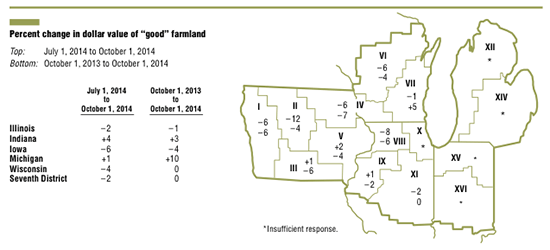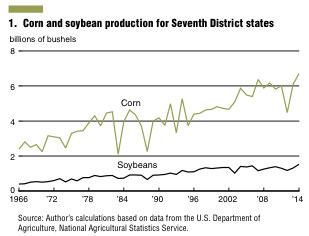
Farmland values in the Seventh Federal Reserve District were down 2 percent in the third quarter of 2014 from the second quarter, yet were unchanged on a year-over-year basis. Declines from a year ago in "good" agricultural land values for Illinois and Iowa were offset by increases for Indiana and Michigan; meanwhile, Wisconsin farmland values remained the same. According to the 224 agricultural bankers who provided responses for the October 1 survey, expectations for a fourth quarter drop in District farmland values dominated: 56 percent of the survey respondents anticipated a decrease in farmland values in the fourth quar- ter of 2014 and only 1 percent anticipated an increase.
For the third quarter of 2014, District agricultural credit conditions exhibited similar patterns to those of recent quarters. Repayment rates for non-real-estate farm loans were lower in the third quarter of 2014 relative to the same quarter last year, and loan renewals and extensions were higher. Funds availability was up a bit for the third quarter of 2014 relative to a year ago. A surge in the demand for non-real-estate loans compared with a year ago con- tributed to the average loan-to-deposit ratio for the District rising to 69.5 percent-its highest level since the second quarter of 2011. Average interest rates on farm operating loans and feeder cattle loans in the third quarter of 2014 remained close to their record lows, and the average in- terest rate on farm real estate loans moved down to near its record low.
Farmland values
The downturn in crop prices of the past two years finally extinguished the trend of rising farmland values that had prevailed in the District since the fourth quarter of 2009. Even though there was no year-over-year change in farm- land values for the District as a whole, Indiana and Michigan saw gains and Illinois and Iowa saw losses in agricultural land values from a year ago (Wisconsin saw no change). The District's 2 percent quarterly decrease in farmland values for the third quarter of 2014 was the largest drop since the end of 2008 (and only the third decrease since then). Besides Michigan, every District state (or a portion thereof) experienced some kind of decrease in farmland values (see map and table below).

The continuation of a dramatic decline in corn and soybean prices helped drive down farmland values across most of the District. According to the U.S. Department of Agriculture (USDA), corn prices averaged $3.72 per bushel in the third quarter of 2014-down 20 percent from the previous quarter and down 39 percent from a year ago. At an average of $12.13 per bushel in the third quarter of 2014, soybean prices were down 15 percent from the previous quarter, as well as from a year ago. The USDA predicted that the five District states' harvest of corn for grain in 2014 would set a record and be 10 percent greater than the harvest of 2013 (see chart 1). For the five District states, 2014 soybean production would also break a record, climbing 17 percent from 2013 according to USDA projec- tions. Besides setting records for the District, 2014's harvest would set national records. However, the bumper crops only partially compensated for lost revenue from the plunge in crop prices, particularly for corn.
In contrast, livestock profits improved in the third quarter of 2014 because of higher livestock product prices and lower feed costs relative to a year ago. USDA data showed that relative to the third quarter of 2013, milk, cattle, and hog prices were up 24 percent, 29 percent, and 14 percent, respectively. Some farmers were reported to have purchased livestock in order to feed them crops har- vested at low prices and possibly recoup some of the lost profits from crop production. Still, the continuing recovery of the livestock sector could not overcome the losses of the crop sector in most of the District and could not pre- vent lower readings on farmland values in many places.

Credit conditions
In the third quarter of 2014, the District's agricultural credit conditions relative to a year ago were pulled in different directions. Compared with a year ago, repayment rates on non-real-estate farm loans were lower in the July through September period of 2014. The index of loan repayment rates dipped to 85 in the third quarter of 2014, as just 5 percent of the responding bankers reported higher rates of loan repayment relative to a year ago and 20 percent reported lower rates. The index of loan repayment rates had not been this low since the second quarter of 2010. Also, loan renewals and extensions on non-real-estate agricultural loans were up this past quarter relative to the third quarter of 2013, with 18 percent of the responding bankers observing more of them and 5 percent observing fewer. Although still showing growth, the index of funds availability fell to 106- its lowest level in six years; 14 percent of the survey respon- dents indicated their banks had more funds available to lend during the third quarter of 2014 than a year earlier and 8 percent indicated their banks had less. Collateral requirements for loans tightened in the third quarter of 2014 relative to the third quarter of the previous year, as 10 percent of the respondents reported that their banks required more collateral and less than 1 percent reported that their banks required less.
The pickup in demand for non-real-estate loans compared with a year ago had lasted four quarters as of the third quarter of 2014. Given that 38 percent of survey respondents observed higher demand for non-real-estate loans than a year earlier and 15 percent observed lower demand, the index of loan demand climbed to 123-a height not reached since early in 2007 (see chart 2). Higher loan demand helped the District's average loan-to-deposit ratio rise to 69.5 percent-8.5 percentage points below the average level desired by the responding bankers. Close to all-time lows, the average interest rates on agricultural loans as of October 1, 2014, were 4.89 percent for operating loans, 5.01 percent for feeder cattle loans, and 4.62 percent for farm real estate loans.
Looking forward
Signs of an imminent downturn in farmland values grew based on the near-term expectations of survey respondents. Only 1 percent of the responding bankers anticipated farm- land values to increase in the October through December period of 2014, and 43 percent expected no change; how- ever, 56 percent forecasted farmland values to decrease. This is the first time since 1998-and only the second time since 1985-that a majority of respondents expected a de- crease in farmland values for the upcoming quarter. Fur- thermore, respondents anticipated the demand to acquire farmland this fall and winter to be weaker than a year ago for both farmers and nonfarm investors. Forty-nine percent of the responding bankers predicted a decrease in the volume of farmland transfers relative to the fall and winter of a year ago, while only 11 percent predicted an increase.


There was a consensus view that net cash farm earn- ings for crop and livestock operations would continue to diverge. Crop farmers faced dire prospects for net earnings this fall and winter relative to the previous fall and winter, as only 2 percent of survey respondents anticipated net earnings from crops to rise over the next three to six months and 92 percent anticipated these earnings to fall. Given the predicted record harvests, the USDA estimated lower price intervals of $3.10 to $3.70 per bushel for corn and $9.00 to $11.00 per bushel for soybeans in the 201415 crop year. Hog, cattle, and dairy farmers should experience continued profitability on account of the reductions in feed costs. Seventy-three percent of the respondents anticipated higher net earnings for hog and cattle operations over the next three to six months relative to a year ago, while 8 percent expected lower net earnings. Similarly, dairy producers should see improved circumstances, as 48 percent of respondents predicted higher net earnings for dairy operations over the fall and winter compared with a year ago and 6 percent forecasted lower net earnings.
Survey respondents anticipated loan repayment rates to decline further this fall and winter (except in Wisconsin), with 5 percent of the responding bankers expecting the vol- ume of farm loan repayments to rise over the next three to six months compared with a year ago and 42 percent expecting this volume to fall. In addition, forced sales or liquidations of farm assets among financially stressed farm- ers were expected to increase in the next three to six months relative to a year earlier, especially in Illinois and Iowa.
Responding bankers forecasted sharply higher non- real-estate loan volume for the October through December period of 2014 compared with the same period of 2013. Predicated on the accuracy of this prediction, the index of non-real-estate loan demand for the fourth quarter of 2014 would be higher than at any point since the 1970s. Not only would there be a higher volume of operating loans in the fourth quarter of 2014 relative to a year earlier, but there would also be higher volumes of feeder cattle loans, dairy loans, and loans guaranteed by the Farm Service Agency of the USDA, according to survey respondents. However, the volumes of farm machinery and grain storage construction loans, as well as farm real estate loans, would diminish during the fourth quarter of 2014 relative to the fourth quarter of 2013.

11.13.2014